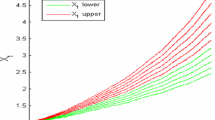Abstract
This paper develops the mathematical framework and the solution of a system of type-2 fuzzy ordinary differential equations (T2FDE). The theory of T2FDEs is developed with type-2 fuzzy initial values, type-2 fuzzy boundary values and type-2 fuzzy parameters. Some natural phenomena can be modelled as dynamical systems whose initial conditions and/or parameters may be imprecise in nature. The imprecision of initial values and/or parameters is generally modelled by fuzzy sets. Here, the concept of generalized H2-differentiability, based on the extension of the class of differentiable type-2 fuzzy mappings or Hukuhara derivatives, is applied. Numerical simulations of type-2 fuzzy differential equations have also been developed. Several illustrative examples have been provided for different T2FDE models related to environmental dynamics and problems in mathematical biology.


















Similar content being viewed by others
References
Abbasbandy S, Viranloo TA, López-Pouso O, Nieto JJ (2004). Numerical methods forfuzzy differential inclusions. Comput Math Appl 48:10–11
Blasi de FS, Myjak J (1985) On the solution sets for differential inclusions. Bull Acad Polon Sci 33:17–23
Bandyopadhyay A, Kar S (2012) Fuzzy continuous dynamic system: A multivariate optimization technique. In: Fuzzy Information Processing Society (NAFIPS), Annual Meeting of the North American. 1–7
Bede B, Gal SG (2005) Generalizations of the differentiability of fuzzy number valued functions with applications to fuzzy differential equations. Fuzzy Set Syst 151:581–599
Bonarini A, Bontempi G (1994) A qualitative simulation approach for fuzzy dynamic models. ACM Transect Comput Simul 4:285–313
Castillo O, Melin P (2008) Type-2 fuzzy logic: theory and applications. Springer, Berlin 29–43
Cano YC, Flores HR (2008) On new solutions of fuzzy differential equations. Chaos, Solitons Fractals 38:112–119
Cano YC, Flores HR (2013) Some remarks on fuzzy differential equations via differential inclusions. Fuzzy Sets Syst 230:3–20
Chang SL, Zadeh LA (1972) On fuzzy mapping and control. IEEE Trans Syst Man Cybern 2:30–34
Diamond P (1999) Time dependent differential inclusions, cocycle attractors and fuzzy differential equations. IEEE Trans Fuzzy Syst 7:734–740
Dubois D, Prade H (1982) Towards fuzzy differential calculus part 3: differentiation. Fuzzy Sets Syst 8(3):225–233
Ghazanfari B, Niazi S, Ghazanfari AG (2012) Linear matrix differential dynamical systems with fuzzy matrices. Appl Math Model 36(1):348–356
Hamrawi H (2011) Type-2 fuzzy alpha-cuts, De Montfort University, Ph.D. thesis
Hamrawi H, Coupland S, John R (2010) A novel alpha-cut representation for type-2 fuzzy sets. IEEE Int Conf Fuzzy Syst 1–8
Hamrawi H S, (2009) Coupland, type-2 fuzzy arithmetic using alpha-planes. In: Proceedings of IFSA-EUSFLAT, Portugal, 606–611
Hindmarsh JL, Rose RM (1982) Nature London 296:162
Holling CS (1959) Some characteristics of simple types of predation and parasitism. Can Ent 91:385–398
Hüllermeier E (1997) An approach to modelling and simulation of uncertain dynamic systems Fuzziness. Knowl-Based Syst 5:117
Kaleva O (1987) Fuzzy differential equations. Fuzzy Set Syst 24:301–317
Kar TK (2010) Chakraborty, K, Effort dynamics in a prey-predator model with harvesting. Int J Inf Syst Sci 6(3):318–332
Kaufmann A, Gupta M (1985) Introduction to fuzzy arithmetic theory and applications. Van Nostran Reinhold Co., Inc., New York
Khastan A, López RR (2015) On periodic solutions to first order linear fuzzy differential equations under differential inclusions’ approach. Inf Sci 322:31–50
Khastan A, López RR (2016) On the solutions to first order linear fuzzy differential equations. Fuzzy Sets Syst 295:114–135
Klir G, Yuan B (1995) Fuzzy sets and fuzzy logic: theory and applications. Prentice Hall, Upper Saddle River
Lotka AJ (1920) Analytical note on certain rhythmic relations in organic systems. In: Proceedings of National Academy of Science U.S. 6, 410–415
Lorenz EN (1963) Deterministic nonperiodic flow. J Atmos Sci 20:130–141
Mahata A, Roy B, Mondal SP, Alam S (2017) Application of ordinary differential equation in glucose-insulin regulatory system modeling in fuzzy environment. Ecol Genet Genomics 3(5):60–66
Mazandarani M, Najariyan M (2014) Differentiability of type-2 fuzzy number-valued functions. Commun Nonlinear Sci Numer Simul 19:710–725
Mendel JM (2007) Type-2 fuzzy sets and systems: an overview. IEEE Comput Intell Mag 2(2):20–29
Mosleh M (2013) Fuzzy neural network for solving a system of fuzzy differential equations. Appl Soft Comput 13(8):3597–3607
Mukherjee D (2003) Stability analysis of a stochastic model forprey-predator system with disease in the prey. Nonlinear Anal: Modell Control 8(2):83–92
Puri M, Ralescu D (1983) Differential and fuzzy functions. J Math Anal Appl 91:552–558
Raczynski S (1996) Differential inclusions in system simulation. Trans Soc Comput Simul 13(1):47–54
Flores HR, Medar MR (2002) Embedding of level-continuous fuzzy sets on Banach spaces. Inform Sci 144:227–247
Salahshour S, Allahviranloo T, Abbasbandy S (2012) Solving fuzzy fractional differential equations by fuzzy Laplace transforms. Commun Nonlinear Sci Numer Simul 17(3):1372–1381
Seikkala S (1987) Towards the theory of fuzzy differential equations. Fuzzy Sets Syst 24:319
Xu X, Zeng Z, Xu J, Zhang M (2017) Fuzzy dynamical system scenario simulation-based cross-border financial contagion analysis: a perspective from international capital flows. IEEE Trans Fuzzy Syst 25(2):439–459
Zadeh LA (1975) The concept of a linguistic variable and its application to approximate reasoning-1. Inf Sci 8:199–249
Author information
Authors and Affiliations
Corresponding author
Rights and permissions
About this article
Cite this article
Bandyopadhyay, A., Kar, S. System of type-2 fuzzy differential equations and its applications. Neural Comput & Applic 31, 5563–5593 (2019). https://doi.org/10.1007/s00521-018-3380-x
Received:
Accepted:
Published:
Issue Date:
DOI: https://doi.org/10.1007/s00521-018-3380-x




